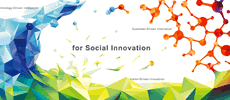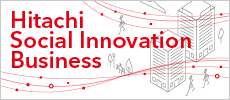Seventh Kyoto University Symposium of Hitachi Kyoto University LaboratorySocial Implementation of New Value
Highlight
For all its tendency to focus on economic value, modern society is also taking a growing interest in other diverse forms of value, not the least of which is human-centered social value and the environmental value that underpins sustainability.
Held this year for the seventh time, the Kyoto University Symposium of Hitachi Kyoto University Laboratory provided a venue for experts from industry and academia to share their respective visions and concerns through presentations and discussions. The debate considered how society can realize new forms of value that go beyond economic value alone and strike a balance between the different things that constitute value for different stakeholders, which at first glance appear to be in opposition to one another.
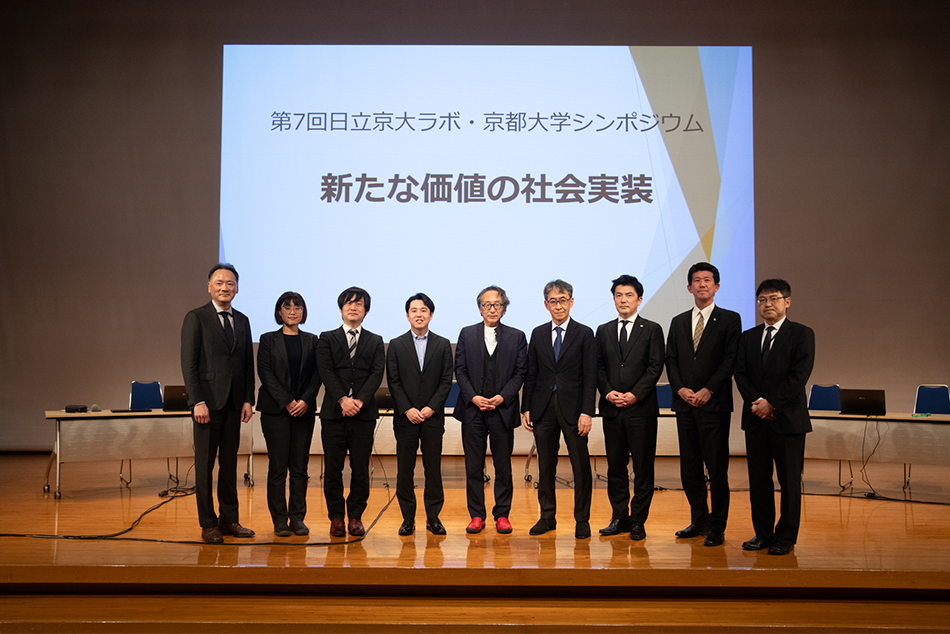
Opening Address
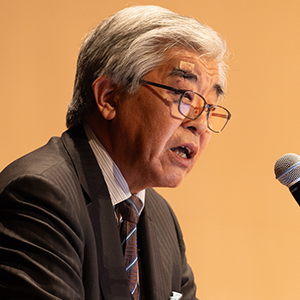 Norihiro Tokitoh
Norihiro Tokitoh
Vice-President, Kyoto University
Since its establishment in 2016, the Hitachi Kyoto University Laboratory has engaged with experts, researchers, students, and others at Kyoto University on research into new social innovations in an “Exploration of Basics and Theory Based on Understanding of Homo sapiens and Culture.” It was as part of these efforts that the Seventh Kyoto University Symposium of Hitachi Kyoto University Laboratory was held in March 2025 on the topic of “Social Implementation of New Value.”
The event was opened by Norihiro Tokitoh, Vice-President of Kyoto University, who expressed his expectations for the discussions to take place at the symposium as follows.
“While modern society has to date placed an emphasis on economic value, recent years have seen growing interest in various other forms of value, notably human-centered social value and environmental value that calls for sustainability. This then raises the question of how society should implement these forms of value in a way that addresses both the different priorities of different stakeholders and the associated complex interplay of costs and benefits. It is my hope that today’s symposium will allow for more in-depth debate and provide a degree of insight into how to go about the practical realization of these goals.”
Keynote Presentation 1
The Value Century: Toward a Multi-layered Society of Value
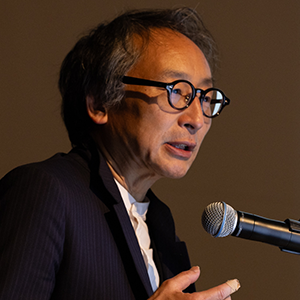 Professor Yasuo Deguchi
Professor Yasuo Deguchi
Dean, Graduate School of Letters, Kyoto University
The 20th century was the century of science, technology, and economics, and the 21st century is a century of values that addresses the questions of what constitutes genuine wellbeing and what value we should pursue. Professor Yasuo Deguchi, Dean of the Graduate School of Letters at Kyoto University, has practical measures to offer for how such value can be realized, and he explores new possibilities in philosophy and the humanities for achieving multi-layered value through his work at the Kyoto Institute of Philosophy.
While “value” is a familiar word, it is an abstract concept and has different meanings to different people. Value comes in three different forms, namely truth (the value of knowing what is real), virtue (the value of morals and ethics), and aesthetics (the value of beauty) in a broad sense. Through the 19th and 20th centuries, value emerged as a philosophical standard encompassing all three of these concepts.
Let us visit the question, “What is value?” I have come to think of philosophical principles by relating values to physical actions. Before defining value, let us briefly describe the range of physical actions. When we say physical actions, they include all sorts of different actions in our daily lives, between getting up in the morning and going to sleep at night. They also include actions over the course of a year, or over a decade. You could even think of a person’s life as a physical action taken over a period that spans multiple decades. By continuing to have a single value, these various actions are bound together, and by facing the same direction, individual actions are given consistency. In organizations such as companies and universities, by verbalizing values, making each member understand them, and sharing them, individual actions can be coordinated and harmonized. In this sense, it is “value” that ties all these different physical actions together and gives them a clear direction.
During the 20th century, progress in science, technology, and economics was valued as making the world better. In reality, unfortunately, this progress in science and economics did not always make people happier, societies have failed to improve and wars have not been eliminated. It has become clear that improving efficiency on its own does not realize good value, giving rise to efforts to imbue the fields of economics and technology with value through approaches such as welfare economics or environmental economics. Going forward, economic frameworks that emphasize new value will likely come to the fore in fields such as wellbeing economics. The 20th century was called the century of science, technology, and the economy, and the 21st century, in which we are being asked again what values we aim for, can be called the century of values.
If so, this raises the questions, “What is virtue?” and “What is wellbeing?” For example, it is possible to produce a consistent key performance indicator (KPI) for the environment such as CO2 or air temperature, but the value of things like virtue and wellbeing vary across different societies, cultures, and communities. That is, considering multi-dimensional and multi-layered forms of value requires that you also take account of individuality, culture, society, time, relativity, and multi-dimensionality. Given this lack of single right answers, the challenge for our age, then, is how to come up with and combine multi-dimensional answers.
It is against this backdrop that the Kyoto Institute of Philosophy is seeking to create a multi-layered society of value. This is a society in which individuals who possess a variety of different identities and values coexist. Rather than a neutral mixture of various forms of value that differ from (or in some cases conflict with) one another, this is a society where these forms of value coexist in ways that embrace their differences. This is the basis of how our identities manifest, and I believe that the role of philosophy and the humanities lies in working out how to address questions and suggest multi-layered values that have no single right answer.
Rather than narrowing down diverse ways of thinking into a single approach, we seek to create value by offering a wider range of options. Persuasiveness and legitimacy are important to this endeavor. Philosophers of the past have bequeathed us with diverse ideas about value. Whereas the modern Western concept of humanity sees self-independence as an ideal, with education systems having been designed to equip people with such attributes, I am putting forward a diametrically opposed view of humanity as “WE-turn” and “Self as WE.” This is the idea that people are not self-standing. Independent “I” is an illusion. Rather, what is needed for an individual “I” to exist is a “WE” that encompasses people other than ourselves as well as the natural environment and all sorts of non-human beings such as plants and animals, including even artificial intelligence (AI) and robots.
While this approach represents one aspect of this philosophy, the first step toward a multi-layered society of values is to make the different value visible and to gather together others who are following the same path. As I hope that the Kyoto Institute of Philosophy can continue to serve as a hub that connects to a worldwide network, I invite all of you here today to come and join us in what we are doing.
Keynote Presentation 2
Efforts to Achieve Practical Realization through Citizen Value Design
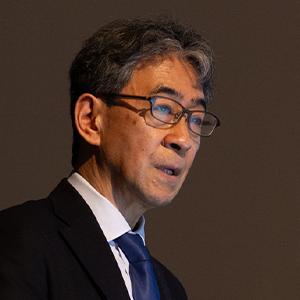 Taku Iwasaki
Taku Iwasaki
Senior Corporate Officer, Hakuhodo Inc.
Fellow, Institutional Advancement and Communications Office, Kyoto University
Society is undergoing ongoing structural changes. Hakuhodo Inc. takes a holistic approach to identifying these changes from the perspective of the sei-katsu-sha, the people who live in that society, advocating the use of “sei-katsu-sha value design” that focuses on both social and economic value. In this presentation, Taku Iwasaki, Senior Corporate Officer at Hakuhodo Inc. and a Fellow of the Institutional Advancement and Communications Office at Kyoto University, drew on examples of research done by the Hakuhodo DY Kyoto University Laboratory and its practical implementation to describe how new value is realized.
The philosophy behind the “sei-katsu-sha value design” concept advocated by Hakuhodo is based on the idea of people as members of society. That is, while marketing is typically targeted at consumers, meaning the people who buy goods or use services, Hakuhodo’s approach to service delivery is to think of people as “sei-katsu-sha” by considering all aspects of their lives rather than just how they act as consumers.
Marketing concepts evolve with the times. Whereas marketing in the 1990s focused on competitiveness, marketing paradigms have been undergoing major changes over recent times with factors such as relationships with stakeholders and the achievement of a sustainable society having gained greater priority.
In terms of the factors behind this change, we have identified the following three changes.
- Society and the economy (shift from shareholder capitalism to stakeholder capitalism)
- Industry and markets (shift from industry-based markets to markets based on relationships with customers)
- Media (shift from conveying information to co-creating value)
Recently, digital media and platform companies have grown in power, with borderless inter-connection between those entities thought of as traditional media and those who are not deemed to be media at all. At Hakuhodo, this is called the sei-katsu-sha interface. It is fair to say that the influence of media in the broad sense of the term where it represents part of the infrastructure of society is growing, with data links between all sorts of different entities such as smartphones, retail stores, Internet of Things (IoT) devices, and transportation providers.
While the spread of digital media comes with problems of information bias in the form of filter bubbles, echo chambers, and algorithm-dependence, it is also clear that people are more than just passive consumers in this process. For example, many people, especially teenagers, are well aware of the potential biases in social networking services (SNSs) and other information found on the Internet. They seek to control this influence through actions of their own such as making a deliberate effort to get outside their filter bubbles. The Japanese word saikisei combines the meanings of both recursion (a standard practice in data engineering and data science for improving efficiency by applying the same mechanism repeatedly) and reflection (a concept from the field of humanities and philosophy of deliberately choosing one’s future by first taking a step back to get a broader view). These people stepping outside their bubbles are adopting a reflective approach whereby they can be more proactive in their choice of information by taking themselves outside the scope of the algorithms. I believe, however, that the ability to effectively combine these two different approaches will be among our challenges for the future.
We are currently working on updating the idea of treating people as sei-katsu-sha at a culture creation laboratory established in collaboration with academics at Kyoto University. Through a variety of studies, including field work, what we have learned in seeking to unravel the idea of treating people as sei-katsu-sha is how vital it is to ask “Is that really the case?” in areas where we tend to consider things in opposition to one another or to gain control by looking at things from outside. We have a number of practical examples operating in prototype form and I believe it will be important in the future that we proceed in a way that combines both philosophy and practice, utilizing one of these prototypes as a base for further growth.
Presentation 1
My Digital Twin: “Another Me”
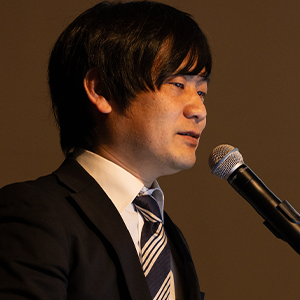 Shinichiro Eitoku
Shinichiro Eitoku
Senior Researcher
NTT Digital Twin Computing Research Center, NTT, Inc
The NTT, Inc Digital Twin Computing Research Center is working on the research and development of a digital twin called Another Me* based on the concept of using a digital version of people to expand possibilities for their real-world selves. Shinichiro Eitoku, a senior researcher at NTT, described how they are going about investigating this technology and trialing it in practice.
The digital twin computing concept being worked on at NTT expands on the existing concept of a digital twin with the goal of building digital twins in cyberspace that incorporate the subjects’ inner self and can interact. One of the specific goals is the “Another Me” being presented here. In addition to building a digital version of a person that can transcend the constraints of the physical world, we are undertaking this research and development based on the hypothesis that having the resulting digital twin function autonomously in public as an extension of the person it replicates will greatly expand opportunities for activity and growth.
At this point, we believe that Another Me requires the following three elements.
- Identity (the capacity to be recognized as the person it replicates)
- Autonomy (the ability to undertake actions without being instructed or externally operated)
- Oneness (the property of giving back to the user what Another Me has done and maintaining a sense of unity between that user and Another Me)
While speaking and other forms of communication are among the potential use cases for an Another Me equipped with these capabilities, we encountered a variety of conflicts once we started thinking about the ways in which Another Me could be used.
For example, while having the digital twin look like the person makes it seem like a true representation of them, there are also cases where an avatar that does not look like you can be treated as if it is you. You can also say that, in essence, it ceases to be you at the point where it becomes a digital representation. In identifying conflicts like this, we went looking for possibilities in philosophy and engaged in joint research with academics from Kyoto University.
If I try to write things that could be considered “me” or “parts of me,” I understand that they are not limited to words that describe me, they also include objects or events that are not even living things. This has led me to consider the possibility that the concept of “me” may consist of two different aspects.
The first is the “Functional I” that represents a person as a collection of functional capabilities. The other is the “Indexical I” of the here and now, the “I” who accomplishes particular actions in a particular place. By combining both of these, our hope is that Another Me will be able to represent an alternative self. We aim to continue with this process of gaining a better understanding of the oppositional nature of self and not-self as we explore new relationships and possibilities for real people and digital existence, having undertaken a number of trials that include replicating the characters of public figures.
- *
- Another Me is a registered trademark of NTT, Inc.
Presentation 2
Joint Effort by Financial Conglomerates and Academia to Create Value for Resolving Societal Challenges
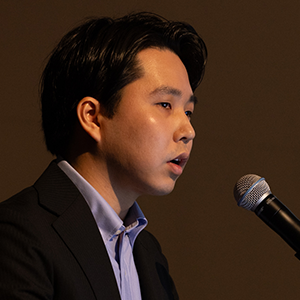 Yosuke Kimura
Yosuke Kimura
Innovation Producer
SMBC Kyoto University Studio, Kyoto University
SMBC Group and Kyoto University established SMBC Kyoto University Studio as part of a collaboration between financial conglomerates and academia to create social value. In this presentation, Yosuke Kimura, an innovation producer at SMBC Kyoto University Studio, describes the work being done at the studio and the flow of new funds aimed at creating social value.
SMBC Kyoto University Studio was established in July 2024 as part of a collaboration between financial conglomerates and academia to create social value. Based on its three objectives of business creation to solve social issues, producing human resources to solve social issues, and the realization of a virtuous cycle through social value creation, the studio engages in joint research with SMBC Group think tanks and Kyoto University academics on various topics such supporting the capabilities of people with developmental disorders to help them find employment.
Creating social value is one of the three core policies of SMBC Group’s current medium-term management plan. There are two reasons for this. The first is the urgent need to overcome challenges facing Japan and the world that are growing in scale and severity. These include environmental problems and aging demographics with a low birthrate. The second is the change in how corporate value is measured, with social value now also being considered alongside conventional economic value.
Given that corporate growth will not be possible without sustainable growth across society at large, SMBC Group is seeking to deliver both economic and social value, treating social issues as the basis for how it contributes to society by addressing these issues whether they relate to finance or not.
When it comes to obtaining new funding for the creation of social value, for example, this involves support for financing and identifying partners across every step from university-based research to practical application, including the initial identification of research topics from early ideas and using the research as a basis for putting the work into practice. We are also working on initiatives for “green” and “social” investment products where funding is directed at areas like sustainable finance or impact investing to provide a framework for ensuring that the money reaches efforts to resolve social issues.
At SMBC Group, we are using the new yardstick of “impact” within our business, using finance to support activities by customers that have a positive influence on society and the environment and reduce negative influences. Examples include providing finance for public-interest projects, using public impact bonds that calculate the monetary value of the societal impact that these projects achieve and pay out incentives, and the establishment of a framework for impact investing to support social startups. This includes determining the impacts that our customers’ businesses will have and providing ongoing support all the way up to formulating an optimal business strategy.
While our hope at SMBC Kyoto University Studio is to engage in ongoing work to encourage actions that bring in people from government, business, and the general public, given that what matters to stakeholders differs depending on their different perspectives, one of the challenges we see for the future is how to convey social value (which unlike economic value cannot always be expressed quantitatively) and expand the scope of collaboration.
Presentation 3
Achieving Society 5.0: Extending a Collaborative Creation Project from Hitachi City to Energize Japan
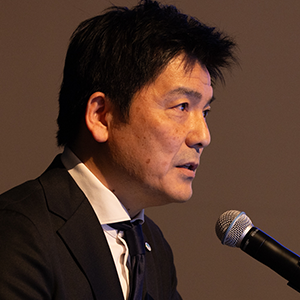 Yutaka Sano
Yutaka Sano
General Manager, Hitachi Co-creation Project, Hitachi, Ltd.
Hitachi is engaged in a variety of initiatives aimed at resolving societal challenges and achieving Society 5.0 that draw on the accomplishments of its Social Innovation Business, a leading example of which is a collaborative creation project in its birthplace of Hitachi City. In this presentation, Yutaka Sano of Hitachi, Ltd., head of the division responsible for this project, explains how they are working in partnership with residents to create a new society for the future and to provide a model for regional revitalization.
Since its founding in 1910, Hitachi, Ltd. has been a supplier of a wide range of products and services that support the infrastructure of society, such as railways and computers, especially in the energy sector with products like turbines and generators. Since 2010, Hitachi has shifted its focus toward its Social Innovation Business that seeks to use data and technology to resolve societal challenges and achieve a sustainable society. With a combined focus on both planetary boundaries and people’s wellbeing, these efforts are aimed at creating a society in which everyone can live a comfortable life while still maintaining a healthy global environment. In the future, approaches based on collaborative creation with communities that include customers, residents, and other stakeholders will be more important than ever to achieving this goal.
It is against this background that Hitachi is engaged in smart city projects around the world. This includes experience with both greenfields projects, where a new city is built from scratch, and brownfields projects, which upgrade existing urban areas. Today I will be presenting examples of both types.
- Kashiwa-no-ha Smart City (Greenfields project)
Led by Kashiwa City in Chiba Prefecture, Mitsui Fudosan, and The University of Tokyo, this project is building a model city of the future based on the concepts of coexistence with the environment, long healthy lives, and new industry development. In addition to its responsibility for regional energy management, Hitachi also operates the Urban Design Studio that focuses on resident participation and is engaged in a health support project for the elderly that uses the Frail Prevention AI. - Collaborative Creation Project in Hitachi City (Brownfields project)
Hitachi City in Ibaraki Prefecture has a very close association with Hitachi the company, to the extent that it is said about 70% of residents have a connection with the Hitachi Group. Nevertheless, just like other regions, Hitachi City is grappling with the multifaceted societal challenges of a falling population, aging demographics, shrinking public transportation services, and CO2 emissions from industry. In response, Hitachi is pursuing collaborative creation efforts across a range of sectors, including providing systems to support decarbonization by the region’s small and medium-sized enterprises based on the concepts of being a green industry city; digital health, medical, and nursing care; and smart technologies for public transportation.
To create the society of the future, it is essential that all residents work together with a sense of being personally engaged in the issues being faced. Having estimated that there are more than 100 other places in Japan that face a similar situation to Hitachi City, Hitachi hopes that it will be able to contribute to revitalization throughout the country through the nationwide deployment of solutions established in this project.
Presentation 4
Quantitative Assessment of Regional Policies and Values
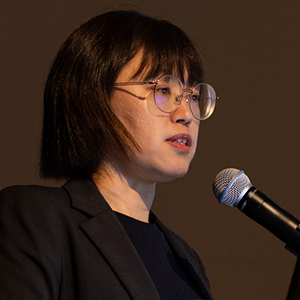 Misa Owa
Misa Owa
Senior Researcher, Center for Exploratory Research, Hitachi Kyoto University Laboratory, Research & Development Group, Hitachi, Ltd.
While it is recognized that the social and environmental value as well as the economic value of policies are important for sustainable development of regions, it is difficult to assess social value using objective indicators alone. There are cases where adopted policies have failed to gain acceptance among local residents. Here, Misa Owa, a researcher at Hitachi’s Center for Exploratory Research and the Hitachi Kyoto University Laboratory, describes research being done at the laboratory on new techniques for assessing social value based on people’s subjective values.
In simulations of future scenarios for Japan conducted through research at Hitachi Kyoto University Laboratory, it was found that, rather than concentrating everything on a small number of cities, what is needed to enhance regional sustainability is the shift to regionally distributed forms of living. For this to happen, it is also important that the various stakeholders, including residents, businesses, and local government, take the initiative in selecting policies and putting them into practice.
The laboratory has previously developed objective simulations that calculate regional policy effectiveness based on criteria such as the economy and the environment. These simulations calculate policy effectiveness by first building a regional model based on information acquired from sensors on the ground and from open sources of data.
The method was used to investigate policies for making regions self-sufficient in energy derived from nature. Detailed simulations were performed of the economic and environmental outcomes of combining different forms of electricity generation and different generation capacities. The results indicated that policies that performed well on one indicator could potentially not perform well in terms of other indicators. For example, the policy that provided the best distribution within the region also came with poor performance in terms of CO2 emissions and cost savings.
As the indicators that people consider to be important differ depending on their perspectives and values, it is difficult for one policy to optimize all indicators.
Accordingly, in addition to conventional simulations that use objective data to evaluate outcomes based on economic and environmental value, we felt that there was a need for subjective simulations that also considered social value, reflecting regional objectives and residents’ sense of wellbeing. One example of this is the practice of assessing social impacts to build better communities. This uses a logic model that represents the logical links between factors in a graph or similar and involves building a model that takes policies as its input, treats the goal that the region wants to achieve as the final impact, and uses large numbers of indicators and links to represent the intermediate stages between these.
In practice, we worked with a local government in Kyushu to evaluate community health and wellbeing policies on the basis of social value and held workshops on building a model. This involved the participants discussing what sort of community they wanted to live in to identify which indicators were important and then evaluating them quantitatively. This method allows different policies to be ranked by quantifying the impacts they will have on the community and it was found that it enabled policies to be chosen that suited the community better as the use of qualitative information to quantify the impact that policies will have on social value allowed for comparisons between policies, which were previously difficult to compare.
Going forward, we intend to conduct further research into the use in policy evaluation of the criteria people use when making value decisions. Our hope is that this will help decision-making on regional policies to reflect a wide range of different values.
Panel Discussion
Social Implementation of New Value
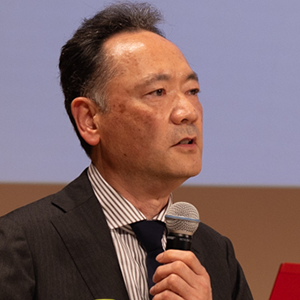 [Moderator]
[Moderator]
Hiroyuki Mizuno
Director, Hitachi Kyoto University Laboratory, Center for Exploratory Research, Research & Development Group, Hitachi, Ltd.
MizunoI would like to conduct today’s panel discussion in two parts. To begin with, people cannot stand alone and there are very tight limits on what any single company can accomplish on its own. Considering what Professor Deguchi describes as our “fundamental incapability,” I would like each of you to comment on this in terms of your own past “incapabilities.” While presentations typically deal with what you have accomplished or what you plan to do in the future, what I would like from you here instead, as much as possible, is for you to talk about what you have not been able to do.
IwasakiWhile one strength of marketing lies in creating a variety of prototype measures in the process of making an impact from the demand-side, we are unable to establish the infrastructure for their reliable rollout on our own, so this will become a major issue in the future. There are also human resource problems. While there are plenty of people available with the skills to provide services for corporates on a business-to-business (B2B) basis, few are equipped to provide business-to-society (B2S) services for the public. How to secure such a workforce will likely become an issue of concern.
EitokuUltimately, I see the mission of engineering lies in the production of goods. However, to give one example, when determining the requirements for the Another Me digital twin I talked about in my presentation, I felt that the engineering discussion about what is and what is not needed, what to leave in and what to take out, is still ongoing. Then again, when listening to the other presentations, it occurred to me that not deciding could well be the right thing to do. Settling on one particular thing could in fact be not optimal, or at least that was how I felt.
KimuraWhile education is one field of research at SMBC Kyoto University Studio, it can be difficult to translate research targeted at in-school education into business or economic value. This has got me thinking about what actions we could take to get all sorts of different companies involved in creating social value that is driven by the issues facing children. Unfortunately, we are still bad at quantifying or articulating social value and I see this as something to address in the future.
SanoIn my involvement in smart city projects, rather than trying to solve transportation problems solely by transportation solutions, for example, we adopt an approach that looks for better outcomes by combining these solutions with initiatives in other areas. When you do that, however, you face the dilemma that addressing a mix of challenges gets more stakeholders involved and makes the solutions much more complicated. In the example of Hitachi City, I spoke about earlier, Hitachi City and Hitachi the company have very deep historical links and considerable expectations are placed on the company to provide solutions to diverse local issues. In practice, however, there is a limit to how much any single company can do on its own nowadays. While there are things we could have done in the past that are no longer possible, we are currently working in partnership with a wide range of stakeholders.
OwaWhile we have received a lot of help in our past research from those who have mediated between our own activities and people from local government or the community, when we move on to somewhere else and hope to accomplish the same things on our own, it feels like this becomes an impediment. In particular, the more you go out into the regions, you find at times that there is a line drawn between locals and outsiders and it can be difficult to get the true story. Finding people who can connect the two sides poses a major challenge.
MizunoThank you. Next, I will ask the presenters to offer their suggestions and comments on the topics that have been covered today. Taku Iwasaki of Hakuhodo spoke about setting up infrastructure for reliable policy delivery and some of the human resource issues. Sano-san, could you please give us your thoughts on this.
SanoI am very interested in the concept of sei-katsu-sha from a marketing context. One question I have is what insights can you offer about sei-katsu-sha as a value producer?
IwasakiOne example of our work at Hakuhodo is a car-sharing initiative in the town of Asahi in Toyama Prefecture. We provide digital infrastructure to match the transportation needs of local people with rides available in private cars, thereby making transportation available to elderly people who find it difficult to get about by themselves. However, both the elderly in need of a ride and those who offer to take them are local residents. While you could think of the people who use the service as being consumers and the people with the cars as the providers, in reality the relationships between them are not that clear cut, with both parties in a certain sense being both a producer and a consumer. For example, the infrastructure of the town is created by the users using the system whereas the ride providers experience the joy of giving someone else a ride. This is what we mean by sei-katsu-sha.
SanoThank you. Each of us play a mixture of roles, being workers during the day, family members at night, and consumers on the weekend. I see this in itself being a manifestation of a society where value is multi-layered.
MizunoEitoku-san of NTT commented that, while what is and is not needed in engineering terms is never finally decided, the decisions that are made may not necessarily be correct. Owa-san, as a fellow researcher, what are your thoughts on this.
OwaIn undertaking research, it is very important to produce something that is useful to society in some way. For example, users of a particular product accept and use it because they perceive the benefits gained from using that product to be positive. As such, it seems to me that this can be seen as guiding users toward particular decisions. This raises the question of whether the very act of making decisions on behalf of others is appropriate. I believe that when individuals perceive an issue is personally relevant, there naturally arises a sense of "something that must be done." It would be ideal if engineers could effectively identify and respond to these needs, providing efficient support that arises from the users themselves.
MizunoThis is taking us into a rather in-depth debate. Next, I will ask Iwasaki-san of Hakuhodo to offer any suggestions he may have regarding what Yosuke Kimura of SMBC Kyoto University Studio had to say about the difficulty of coming to grips with the specifics of social value and his struggles to quantify and articulate it.
IwasakiWhile Kimura-san spoke about various investment products and other practices in the context of how mechanisms for the flow of economic value can be created within the realm of social value, is there not also another approach that involves revisiting the question of what economic value actually is? While social value is defined qualitatively and subjectively, there are also many subjective elements to economic value that cannot be accounted for purely in terms of monetary amounts alone. I believe that a key factor in the creation of economic value lies in how we lack a good grasp of these elements. It seems to me that addressing this question through philosophy will allow us to create new pathways for social value and other mechanisms. What do you think?
KimuraAs you say, I see the creation of mechanisms to facilitate the distribution of both social and economic value as something that financial conglomerates should be addressing. On the other hand, revisiting what economic value actually is comes as a new idea to me. When you consider examples such as artworks that are priced at a level that prompts you to ask whether they are really worth so much, or how prices change rapidly when lots of people realize how valuable something is, I believe that phenomena like these embody something of what human beings really are and, as such, I expect that looking at them in philosophical terms would make sense.
MizunoMoving on, Yutaka Sano of Hitachi spoke about how, whereas urban development should be able to achieve synergies by combining a variety of different policies, doing so increases the number of stakeholders involved, which can make it harder for projects to proceed. He also talked about how things that could be done in the past are now difficult to get accomplished, something that strikes me as another reflection of the complex world in which we now live. I would like to ask Yosuke Kimura of SMBC Kyoto University Studio to comment on this.
KimuraStarting with the work going on at Hitachi City, I felt that you have been engaged in projects that draw on a truly large number of people and make consensus-building difficult. I also understand that choosing who to approach, and in which order, is important if a project is to proceed smoothly while still taking into account a variety of different values. If you have any strategic measures or other tricks that could help with this, I would like to hear about them.
SanoWhat is important, first of all, I believe, is to get people on board by getting them to understand what we are doing and how we are approaching it, and to encourage behavior change. Professor Deguchi, in his keynote presentation, spoke of value as a driver and a vector that determines the direction for action. If you are trying to put an established community onto a pathway toward further growth, I see one approach as being to align the sense of direction of the residents and other stakeholders.
MizunoFinally, Misa Owa of Hitachi spoke about how difficult it can be to become part of a community and get things done. Shinichiro Eitoku of NTT, could you please give your researcher’s perspective on this?
EitokuWhile this is easy enough to understand in terms of what you can and cannot accomplish, when I think about the difficulties of gaining acceptance when it comes to the parts where this is not the case, this is something with which I can empathize. In talking to people in the local community, I expect there are insights you have gained and other examples of where things have gone well.
OwaI believe it is important to consider matters from the other person’s point of view. While it is very important to explain the nature of our research work and its goals, I also always try to be cognizant of how the people involved feel about our presence and how we ourselves would feel if matters like this were suddenly brought up with us.
MizunoThank you everyone. Finally, I would ask Professor Deguchi to conclude with his recap of today’s program.
DeguchiToday’s symposium has given us a variety of presentations on the topic of value. While we want value to serve as a vector that aligns the directions we take, there are also things that value cannot do on its own. Even if we are able to make progress toward accomplishing our work, actually completing the process is even more difficult, I believe. Take the expression, “leading a full life” as an example. What this means in practice will differ depending on the person’s values. For example, while having a peaceful death is one way of achieving “completion,” however much attention we might pay to our health, we cannot ensure a peaceful death for ourselves. That is, we all have things which we are fundamentally incapable of doing. But it is also not true that there is nothing we can do. Whether it be people’s lives or corporate activity, there will always be occasions when we are unable to get to where we want to go or when we suffer failure or frustration. Nevertheless, that which we cannot accomplish ourselves we can hand on to others. This applies broadly, including to companies, generations, and society as a whole. In this regard, we should reassess how we look at sustainability, seeing it not as something linear, but in fact a relay race over a terrain of peaks and troughs, involving interruptions and failures that we recover from. By doing so, I believe we can better see the true nature of the world in which we live.
Closing Address
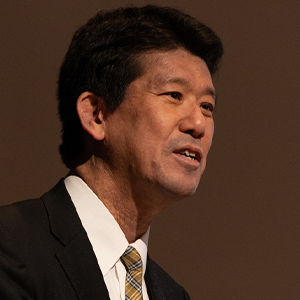 Toshiharu Miwa
Toshiharu Miwa
General Manager, Center for Exploratory Research, Research & Development Group, Hitachi, Ltd.
The program concluded with a closing address by Toshiharu Miwa, General Manager of Hitachi’s Center for Exploratory Research. He recounted the content of the day’s presentations and panel discussion, making the following comments. “On the topic of the social implementation of new value, today’s symposium has reported on work happening in the private sector as well as in academia. I hope that the topics we have shared today will inform your future research and collaborations. At Hitachi Kyoto University Laboratory, we intend to continue using opportunities like this to share issues of concern and to undertake forward-looking initiatives while also deepening our dialog and collaboration with everyone involved.” He thanked the presenters and audience and expressed his hopes for the future activities of Hitachi Kyoto University Laboratory.
* Job titles and affiliations of speakers are current as of March 2025.

